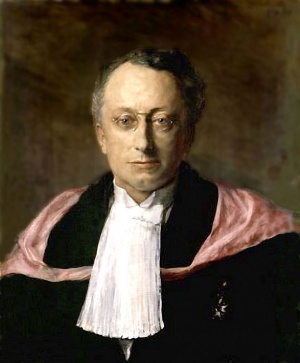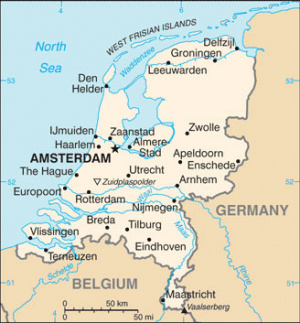Netherlands Statistics
Introduction
This page links to the current online resources available to explore The Netherlands (Dutch) population and birth data.
| Statistics Links: Introduction | Reports | World Population | World Fertility | World Infant Mortality | Maternal Mortality | Australia | Brazil | Canada | China | Germany | India | Indonesia | Europe | Myanmar | Netherlands | Spain | United Kingdom | Romania | Uganda | United States | BGD Tutorial - Applied Embryology and Teratology | National Perinatal Statistics Unit | AIHW | Category:Statistics | |
|
Embryology

|
Ambrosius Arnold Willem Hubrecht (2 March 1853, Rotterdam – 21 March 1915, Utrecht) was a Dutch zoölogist who received his Ph.D. under Halting on a study of the anatomy, histology and development of the worm group Nemerteans. He established the Hubrecht Collection of embryos located initially at the Netherlands Institute for Developmental Biology in Utrecht, Hubrecht Laboratory. In 2004 was relocated to the Museum fur Naturkunde, Berlin and incorporates the Hill collection (James Peter Hill 1873-1954).
|
Historic Biology

|
in 1683. Von Leeuwenhoek discovered that "in the white matter between his teeth" there were millions of microscopic "animals" - more, in fact, than "there were human beings in the united Netherlands," and all "moving in the most delightful manner." There can be no question that he saw them, for we can recognize in his descriptions of these various forms of little "animals" the four principal forms of microbes - the long and short rods of bacilli and bacteria, the spheres of micrococci, and the corkscrew spirillum.
|
Assisted Reproductive Technology
Regulation of assisted reproductive technology in the Netherlands (2000).[1]
General Statistics
- Population: 17,016,967 (July 2016 est.)
- country comparison to the world: 67
Age structure
- 0-14 years: 16.56% (male 1,442,059/female 1,375,479)
- 15-24 years: 12.11% (male 1,050,889/female 1,010,596)
- 25-54 years: 39.83% (male 3,400,998/female 3,377,311)
- 55-64 years: 13.14% (male 1,113,587/female 1,123,165)
- 65 years and over: 18.35% (male 1,411,830/female 1,711,053) (2016 est.)
Median age
- total: 42.5 years
- male: 41.4 years
- female: 43.4 years (2016 est.)
Population growth rate
0.4% (2016 est.)
- country comparison to the world: 167
Birth rate
- 10.9 births/1,000 population (2016 est.)
- country comparison to the world: 181
Death rate
- 8.8 deaths/1,000 population (2016 est.)
- country comparison to the world: 71
Sex ratio
- at birth: 1.05 male(s)/female
- 0-14 years: 1.05 male(s)/female
- 15-24 years: 1.04 male(s)/female
- 25-54 years: 1.01 male(s)/female
- 55-64 years: 0.99 male(s)/female
- 65 years and over: 0.82 male(s)/female
- total population: 0.98 male(s)/female (2016 est.)
Mother's
- Mean age at first birth: 29.4 (2011 est.)
- Maternal mortality rate: 7 deaths/100,000 live births (2015 est.) country comparison to the world: 171
- 1.78 children born/woman (2016 est.)
Infant mortality rate
- total: 3.6 deaths/1,000 live births
- country comparison to the world: 202
- male: 3.9 deaths/1,000 live births
- female: 3.3 deaths/1,000 live births (2016 est.)
Life expectancy at birth
- total population: 81.3 years
- male: 79.2 years
- female: 83.6 years (2016 est.)
- country comparison to the world: 25
HIV/AIDS
NA
Ethnic groups
- Dutch 78.6%, EU 5.8%, Turkish 2.4%, Indonesian 2.2%, Moroccan 2.2%, Surinamese 2.1%, Bonairian, Saba Islander, Sint Eustatian 0.8%, other 5.9% (2014 est.)
Data: The World Factbook Netherlands
References
- ↑ <pubmed>12656080</pubmed>
External Links
External Links Notice - The dynamic nature of the internet may mean that some of these listed links may no longer function. If the link no longer works search the web with the link text or name. Links to any external commercial sites are provided for information purposes only and should never be considered an endorsement. UNSW Embryology is provided as an educational resource with no clinical information or commercial affiliation.
- CBS - Statistics Netherlands Statistics Netherlands (CBS)
- The World FactbookNetherlands
Glossary Links
- Glossary: A | B | C | D | E | F | G | H | I | J | K | L | M | N | O | P | Q | R | S | T | U | V | W | X | Y | Z | Numbers | Symbols | Term Link
Cite this page: Hill, M.A. (2024, April 27) Embryology Netherlands Statistics. Retrieved from https://embryology.med.unsw.edu.au/embryology/index.php/Netherlands_Statistics
- © Dr Mark Hill 2024, UNSW Embryology ISBN: 978 0 7334 2609 4 - UNSW CRICOS Provider Code No. 00098G
